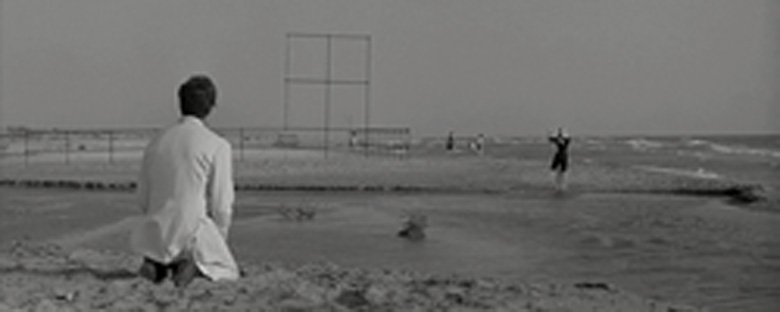Reviews
The Sweet Life
Federico Fellini
Italy, 1960
Credits
Review by Rumsey Taylor
Posted on 02 December 2004
Source Kock Lorber Films DVD
Related articles
Reviews: 8 1/2
Reviews: I Vitelloni
Reviews: The White Shiek
Marcello is a tabloid journalist, usually flanked by an army of photographers. His job requires suaveness and temporary sincerity—he must be likable, easily trusted, and never committal, for the actress he’s pampering one day may be exploited the next. He’s very good at what he does, and it ruins his personal life.
Thusly, La Dolce vita is an ironic title for this film. Like the headline of a tabloid, it’s disingenuous, protecting the true depression of its principle character. Marcello appears always kempt and happy; he’s like a retired James Bond. Judging from his looks and ample social activity, one would not likely anticipate the overbearing wife he has at home (the two reside in a sparse, white apartment in which Marcello, in a black suit, is a volatile contrast). He satisfies his libido with women of varying aspects of physical beauty; he bounces from a brunette to a voluptuous blonde, and so forth. These relationships may be active, but are temporary and lack intimacy. Age is the opponent of a free spirit, and Marcello, graying hairs becoming evident on his head, begins to consider the security intimacy might afford him. He is impressed with the life of a fellow aristocrat, but his is also empty—at a party at the aristocrat’s apartment, the group listens to his recordings of nature. The experience is analogous to Marcello’s affairs, citing the companions’ preference for superficiality over real experience.
Marcello’s desired security in his life becomes analogous to religious faith—the film details his strife to believe that security is attainable. Federico Fellini amplifies this with a triumvirate of religious icons. The film’s famous opening displays the image of Christ laughably, hoisted above with outstretched arms by a helicopter (“Look. It’s Jesus.”). Later, one of Marcello’s assignments leads him to a prophetic, curative Madonna tree. The hype attracts a lecherous, skeptical crowd as well as a film crew, and the plant is torn limb from limb. Amidst the mob, we find a corpse, an older man who sought remedy for his ailing body. The death seems to verify skepticism.
La Dolce vita is principally cynical, and ends with an ambiguous, hopeful notion of faith. A monstrous fish is dragged to a shore. It looks real, yet is unlike anything the present company has ever seen before. This find accompanies Marcello’s final opportunity for redemption, as a woman on an opposite shore (an innocent waitress he met earlier in the film) gestures an invitation. He does not recognize the message, exits, and the girl’s gaze of hope directs towards the viewer in the film’s staggering and ambiguous final shot.
We don’t do comments anymore, but you may contact us here or find us on Twitter or Facebook.



